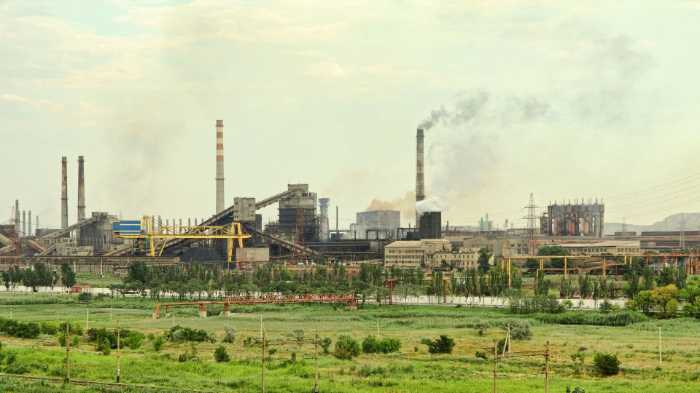
Most people don’t realize that the business sector is responsible for 70% of GHG emissions. So if you are in business, you may be feeling a little pressure to become more transparent about your sustainability efforts. Climate change is a pressing global issue, and it’s important for businesses to do their part to reduce their carbon footprints. In this blog post, we will discuss 10 ways that your business can take action on climate change and reduce its environmental impact. Many of these steps are simple and easy to implement, so there’s no reason not to get started today! If you want to improve your ESG score, then here is a list to get you started.
- What is climate change?
- 10 ways to reduce greenhouse gas emissions for businesses
- 1. Switching to renewable energy sources
- 2. Transitioning to low-emission transportation options
- 3. Sustainable manufacturing practices
- 4. Waste management
- 5. Carbon offsets
- 6. Investing in clean technology research and development
- 7. Telecommuting or working remotely
- 8. Educating customers about climate change
- 9. Plant trees
- 10. Setting science-based emissions reduction goals
- What are the benefits of climate action taken by businesses?
- 1. Improve public perception
- 2. Operational savings
- 3. Future-proof operations
- 4. Improved competitiveness
- 5. Increased innovation
- 6. Improved resource efficiency
- Conclusion
- Faqs
- How can a business make its supply chain more climate-friendly?
- How can a business improve its energy efficiency to reduce energy consumption?
- What is the amount of greenhouse gases of an average American business?
- What is the difference between combustion engines and electric vehicles?
- How does the vast majority of our energy use directly affect the climate?
- What are some ways that food companies are changing their business models to lower emissions?
What is climate change?
Climate change is one of the most pressing challenges of our time. Also known as global warming, this phenomenon is caused by an increase in atmospheric greenhouse gases, which trap heat and create changes in our climate system. Due to human activity such as industrialization, deforestation, and the release of greenhouse gases into the atmosphere, average global temperatures are increasing at a rapid rate. This has serious consequences for many aspects of life on Earth, including rising sea levels and increases in extreme weather events like storms and droughts.
10 ways to reduce greenhouse gas emissions for businesses

Businesses play a critical role in reducing greenhouse gas emissions and mitigating climate change. There are many ways businesses can reduce their emissions, including:
1. Switching to renewable energy sources
The most effective action businesses can take to reduce their greenhouse gas emissions is using renewable energy sources, such as solar and wind power. These sources produce significantly less carbon dioxide emissions than traditional sources, such as coal and natural gas. Additionally, businesses can focus on energy efficiency by investing in updated equipment or technology that reduces the amount of energy needed for operations.
The amount of carbon dioxide emitted by renewable energy sources continues to decrease as technology improves. Additionally, businesses that use renewable energy can often sell any extra electricity they generate back to the grid. This helps to offset the costs of investing in renewable energy infrastructure. Finally, using renewable energy helps businesses send a positive message to their customers and investors that they are committed to taking action on climate change.
2. Transitioning to low-emission transportation options
Another way for businesses to reduce their greenhouse gas emissions is the transition to low-emission transportation options. Electric vehicles, for example, have a much lower carbon footprint than other types of vehicles because they rely on fossil fuels. Switching to electric or fuel-efficient cars can dramatically reduce a business’s carbon footprint and help protect the environment from harmful pollutants.
Additionally, companies can also look into alternative forms of transport, such as public transit or carpooling with employees. By embracing renewable energy and reducing unnecessary transportation costs and emissions, businesses can play an important role in reducing greenhouse gases and helping to protect our planet for future generations.
3. Sustainable manufacturing practices
Businesses have a major role to play in reducing greenhouse gas emissions and mitigating the effects of climate change. A key way for businesses to reduce their environmental impact is through sustainable manufacturing practices. These can include using green materials that reflect or store solar energy, such as reflective coatings, window films, and thermochromic dyes in buildings and vehicles.
Additionally, sustainable manufacturing practices can include conserving resources by using designs that are based on life-cycle analysis, reusing waste products as inputs for new products, and implementing long-term maintenance plans to keep equipment working efficiently. By incorporating these practices into their manufacturing processes, businesses can help reduce their carbon footprint and do their part to combat climate change.
4. Waste management
One way businesses can reduce their greenhouse gas emissions is by implementing waste management programs such as recycling and composting. Recycling helps to reduce the need for new raw materials, which in turn reduces the amount of energy required to produce them.
Composting helps to reduce the amount of waste that goes to landfills, where it decomposes and releases methane, a potent greenhouse gas. By diverting waste from landfills and using it to create compost, businesses can help to reduce their environmental impact.
5. Carbon offsets
Another way for businesses to reduce their carbon footprint is through the use of carbon offsets. Carbon offset programs are designed to counteract the negative environmental impact of greenhouse gas emissions by funding various conservation and mitigation efforts.
Examples of these projects include wind farms, solar technology installations, reforesting efforts, and clean energy initiatives. By funding such projects, businesses can effectively offset their own emissions and promote more sustainable practices across a wide range of industries.
In addition, many companies offer carbon offsets as part of their organizational sustainability programs, helping to ensure that all employees are contributing to increased climate change resilience. Overall, by using carbon offsets as part of their emissions reduction strategy, businesses can take a proactive approach to tackle one of the most pressing environmental challenges facing society today.
6. Investing in clean technology research and development
Clean technology includes a broad range of technologies and solutions that aim to reduce environmental impact. Common examples include solar panels, wind turbines, and electric vehicles. While the upfront cost of clean technology can be high, the long-term benefits – in terms of reduced emissions and improved energy efficiency – make it a worthwhile investment for businesses.
Investing in clean technology research and development helps to bring down the cost of these technologies and makes them more accessible to businesses and consumers. In addition, it creates jobs and drives economic growth. As we strive to meet our climate goals, investing in clean technology research and development is essential.
7. Telecommuting or working remotely
Businesses can reduce their greenhouse gas emissions by encouraging employees to telecommute or work remotely when possible. By allowing employees to work from home or a remote office instead of commuting into the office on a regular basis, organizations can significantly reduce their carbon emissions.
Not only does this allow workers to avoid the stress and congestion of rush hour traffic, but it also drastically reduces the number of vehicles on the road and associated environmental impacts.
Additionally, telecommuting allows businesses to reduce their energy usage by lowering energy demands at company headquarters, which can translate to significant savings over time. As more and more people seek environmentally-friendly solutions to address climate change, encouraging telecommuting or working remotely as an alternative will certainly prove critical for mitigating greenhouse gas emissions in the future.
8. Educating customers about climate change
As the world becomes increasingly aware of the threat of climate change, businesses are under pressure to reduce carbon emissions. One way to do this is by educating customers about the issue and what they can do to help. Many people are unaware of the simple steps that they can take to reduce their carbon footprint.
For example, something as simple as recycling, or stopping plastic use can make a big difference. By educating customers about these issues, businesses can play an important role in reducing emissions.
In addition, customers who are informed about sustainability initiatives are more likely to support businesses that are taking action to reduce their impact on the environment. As awareness of climate change grows, businesses that engage in education and outreach will be well-positioned to succeed in the coming years.
9. Plant trees
A simple and effective strategy for being carbon neutral is to plant trees. Trees act as natural carbon sinks, absorbing carbon dioxide from the atmosphere and converting it into oxygen. In addition, trees help to cool and improve air quality, reducing the need for artificial cooling sources and cleaning out pollution from the air.
By implementing a tree planting program within their organization, businesses can make an important contribution toward limiting climate change and mitigating its effects. Not only does this help to improve the health of local ecosystems, but it also ensures a more sustainable future for all.
10. Setting science-based emissions reduction goals
Setting science-based emissions reduction goals is another way for businesses to fight climate change. By basing their goals on the latest scientific evidence, businesses can ensure that they are taking the most efficient and effective steps to reduce their impact on the environment.
Additionally, science-based goals provide a clear and measurable target for businesses to strive for, helping to keep them accountable for their emissions reductions. While setting science-based emissions reduction goals can be challenging, it is an essential step for businesses that are serious about reducing emissions.
What are the benefits of climate action taken by businesses?

Climate action refers to the steps taken to address climate change. This can include reducing greenhouse gas emissions, planting trees to offset carbon dioxide levels, and developing renewable energy sources. As the evidence of climate change becomes increasingly difficult to ignore, businesses are under pressure to take action. Some companies have been hesitant to make changes, fearing that they will be costly and disruptive. However, there are a number of reasons why taking action on climate change can be beneficial for businesses:
1. Improve public perception
A company’s reputation is important for several reasons. Good public perception can lead to increased sales, employee retention, and investor confidence. In recent years, corporate social responsibility has become an important part of many companies’ reputations. As consumers become more aware of the environmental and social impact of their purchase decisions, they are increasingly likely to support businesses that align with their values.
For example, a study by Nielsen found that 66 percent of global consumers are willing to pay more for sustainable products. By taking action on climate change, businesses can improve their public perception, attracting more customers and employees while building trust with investors.
2. Operational savings
Another benefit to businesses taking climate action is operational savings. By reducing and minimizing their dependence on fossil fuels, businesses can cut down on their energy usage and thus save money on fuel costs. In addition, companies that engage in carbon reduction initiatives like recycling or reducing paper waste can also save money on waste disposal costs.
Overall, these gains translate into increased profits for businesses that take climate action, making these measures not only good for the planet but also good for the bottom line. So if you’re a business owner looking to reduce costs and improve your bottom line, consider implementing some climate action measures today!
3. Future-proof operations
As the effects of climate change become more severe, businesses are facing increased risks to their operations. Extreme weather events can disrupt supply chains, damage infrastructure, and cause havoc for customers. By taking action now to reduce their emissions and build resilience, businesses can protect themselves from these risks and safeguard their future success.
Climate-related risks are already being felt by businesses around the world. In 2018, extreme weather events cost the global economy nearly $400 billion. According to a recent report by the World Bank, these costs are expected to increase exponentially in the coming years as the effects of climate change intensify.
By taking action to reduce their emissions and build resilience, businesses can protect themselves from these risks. For example, Ikea has committed to becoming climate-positive by 2030, which means that it will absorb more greenhouse gases than it emits.
To achieve this ambitious goal, Ikea is investing in renewable energy, creating more efficient supply chains, and developing new products made from sustainable materials. As a result of these efforts, Ikea will be better prepared to withstand the impacts of climate change and continue thriving in the years to come.
4. Improved competitiveness
By taking climate action, businesses can position themselves as leaders in the low-carbon economy and tap into new markets and opportunities. They can also gain a competitive edge by reducing their energy costs and improving their resource efficiency.
In addition, climate action can help businesses build resiliency to the impacts of climate change, such as extreme weather events and supply chain disruptions. As the business landscape evolves in the face of climate change, those who take climate action will be well-positioned to succeed.
5. Increased innovation
By shifting to more sustainable business practices and investing in climate-friendly technologies, companies are able to bring new ideas to the table that can help to tackle some of our biggest environmental challenges. Not only does this result in more cutting-edge products and reduced waste, but it also allows businesses to stand out from the rest and stay ahead of trends.
Whether through reducing their carbon footprint or developing cleaner technologies, businesses that take action on climate change are better positioned for long-term success by encouraging innovation within their industry.
6. Improved resource efficiency
While the impacts of climate change are becoming increasingly apparent, businesses are increasingly taking action to combat this threat. One notable benefit of their efforts is improved resource efficiency. As businesses strive to lower their carbon footprint, they become better at streamlining processes and using resources more efficiently.
For example, many companies are now using renewable energy sources such as solar and wind power, helping to lower greenhouse gas emissions while reducing their reliance on non-renewable fossil fuels. Likewise, many businesses are implementing more sustainable practices when it comes to manufacturing processes and product development. Overall, these actions have the potential to significantly reduce resource consumption, benefiting both the bottom line of businesses and the health of our planet.
Conclusion
Climate change is already costing businesses billions of dollars, and this cost is only going to increase in the years to come. However, by taking action now to reduce their emissions and build resilience, businesses can protect themselves from these risks. Not only will this help them avoid financial losses, but it will also position them as leaders in the low-carbon economy and allow them to tap into new markets and opportunities.
Faqs

How can a business make its supply chain more climate-friendly?
supply chains are complicated operations that involve many different players, from manufacturers to retail outlets. As such, making an entire supply chain more climate-friendly can be a daunting task. However, there are a few steps that businesses can take to make a difference. First, they can choose sustainable suppliers who have better risk management.
Second, they can minimize waste through careful planning and execution. Finally, they can offset their emissions by investing in carbon-reducing projects. By taking these steps, business leaders can make their supply chains more climate-friendly and help to protect the environment.
How can a business improve its energy efficiency to reduce energy consumption?
There are several ways that a business can improve its energy efficiency in order to reduce energy consumption. One strategy is to invest in renewable energy projects, such as solar panels or wind turbines, which generate clean, renewable energy and lower overall energy costs. Another approach is to adopt more efficient lighting and equipment options, such as LED lights or smart appliances.
In addition, businesses can take steps to reduce their carbon footprint by implementing fuel-efficient transportation practices, such as switching to electric or hybrid vehicles. Additionally, businesses can work to improve their energy efficiency and minimize climate-related risks by mitigating climate change through carbon reduction initiatives and compliance regulations. Overall, by taking steps to improve energy efficiency, businesses can help stave off rising climate-related costs and fight the effects of climate change.
What is the amount of greenhouse gases of an average American business?
According to the Environmental Protection Agency, the average American business emits approximately 19 million metric tons of greenhouse gases each year. Greenhouse gases like carbon dioxide and methane trap heat in the atmosphere, causing the Earth’s temperature to rise. Tackling climate change will require businesses to reduce their emissions of greenhouse gases.
There are a number of ways to do this, including using cleaner energy sources, investing in energy efficiency, and adopting sustainable practices. By taking action to fight climate change, businesses can help protect our planet for future generations.
What is the difference between combustion engines and electric vehicles?
The combustion engine, which is found in most cars, trucks, and SUVs, runs on gasoline or diesel. The electric vehicle has a motor that runs on electricity from batteries.
The main difference between the two is how they generate power. Gasoline engines convert chemical energy into mechanical energy, while electric motors convert electrical energy into mechanical energy.
Electric motors are more efficient than combustion engine vehicles. Electric motors are about three times as efficient as combustion engines.
How does the vast majority of our energy use directly affect the climate?
The answer is pretty simple – it all comes down to carbon dioxide emissions. Burning fossil fuels like coal, oil, and natural gas releases carbon dioxide gas into the atmosphere. And since carbon dioxide is a greenhouse gas, it traps heat from the sun inside our atmosphere causing Earth’s average temperature to rise.
What are some ways that food companies are changing their business models to lower emissions?
Many food companies are finding ways to change their business models in order to lower emissions. One way that some companies are doing this is by investing in more efficient and sustainable packaging options. This can help to reduce the number of materials that need to be used, as well as the waste that is produced.
Additionally, many companies are working on increasing the amount of renewable energy that they use. This can help to offset the emissions that are produced from their operations. Finally, some companies are working on reducing the food waste that they produce. This can help to reduce the emissions from decomposing food waste.

Dean Emerick is a curator on sustainability issues with ESG The Report, an online resource for SMEs and Investment professionals focusing on ESG principles. Their primary goal is to help middle-market companies automate Impact Reporting with ESG Software. Leveraging the power of AI, machine learning, and AWS to transition to a sustainable business model. Serving clients in the United States, Canada, UK, Europe, and the global community. If you want to get started, don’t forget to Get the Checklist! ✅
